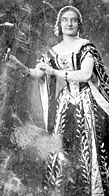 |
||
  |
||
|
|
Scripting the Past: Exploring Women's History Through FilmIntroductionIn this lesson, students employ the screenwriter's craft to gain a fresh perspective on historical research, learning how filmmakers combine scholarship and imagination to bring historical figures to life and how the demands of cinematic storytelling can shape our view of the past. Learning ObjectivesGuiding Question:How do filmmakers bring history to life, and how does filmed history represent (or misrepresent) historical realities?1 Begin by explaining that in this lesson students will examine a figure in women's history through the lens of filmmaking, producing a screenplay based on an autobiographical narrative and their own research into the time period in which that autobiography is set. 2 Introduce students to the filmmaking process with a visit to the Cinema exhibit at the Learner.Org website, accessible through EDSITEment. Here students can learn how the screenwriter, director, producer, actors, and editing team collaborate to create a finished film. Guide students through the exhibit or have them read through it on their own, focusing on the role played by the screenwriter and director. If time permits, students can also try their hand at writing a scene with an online activity. 3 Divide the class into small study teams of three or four students, and have each team choose one of the autobiographical narratives listed below as the basis for their film script. (Note that these autobiographies range from full-length books (Fremont and Tubman) to chapter-length extracts.)
As they read their selected narratives, have students gather preliminary details that they can use in their film scripts. For example: background information about the main character; identifying information about supporting characters; the period and setting for specific events; important or dramatic episodes in the story; lines of dialogue or quotations they might work into their script. In addition, encourage students who have selected a long narrative to choose a portion of the story that seems most suitable for film treatment. 5 After this preliminary reading, help students brainstorm a list of questions they can use to begin visualizing their narrative in film terms. The list should include questions that set a direction for historical research and questions that can be answered by close reading of the narrative itself. The framework below can provide a starting-point.
Visualizing the Scene
Visualizing the Society
Visualizing Character
Visualizing Action
6 When they have prepared their lists of questions, have the student teams gather information for their screenplays. Divide this part of the lesson into three stages, providing ample class time and independent research time for each step in the research and preparation process.
7 Following this preparation, have students outline a plot for their movie, a process that will usually involve reshaping history somewhat to fit storytelling conventions. Remind students of the basic stages of plot development: conflict, complication, crisis, and resolution. Students may also find inspiration in some of the standard formulas Hollywood filmmakers use:
8 Finally, have students script a key scene for their film, including scenic directions and dialogue. Remind students that images tell much of the story in a film, serving to evoke the emotions and thoughts of the viewer. To capture this visual element, students might talk through the scene with their teammates, describing what appears on screen, or they might close their eyes and try to see the action unfolding in their imaginations. Students should also strive to integrate their dialogue into the action of the scene. Rather than have characters deliver speeches, for example, let them talk while they are moving or doing something that will add visual interest to the scene. 9 Conclude this lesson by having each student team present its scripted scene to the class. Then lead a discussion reflecting on the process of translating history into film and the extent to which film conventions may influence our perceptions of the past. Based on their own screenwriting experience, for example, students may have a new insight into the way stereotypes implicitly shape film portrayals of women, ethnic groups, children, occupations, etc. They may also begin to recognize how the assumptions wrapped up in the term "Americana" help determine the kinds of stories we tell about America's past and the values we seek in our history. Use this discussion to explore the power of popularization in historical filmmaking and to foster more critical viewership. Extending the LessonContinue your study of the relationship between storytelling conventions and our perception of historical and social realities by investigating traditions in children's literature. Visit the U.S. Women's History Workshop website for an Electronic Classroom exhibit on Children's Literature that focuses on the way these stories reveal the moral assumptions of a society. Additional resources on children's literature are available in the "Childhood" area of the History of Education website, including World of the Child: Two Hundred Years of Children's Books at the University of Delaware, History of Children's Literature by Kay E. Vandergrift at Rutgers University, and Casting Characters: An Introduction to the History of Juvenile Literature to 1900 by Suzanne Semmes Dennis at Dartmouth College.Standards Alignment View your state’s standards |
||||||||||||||||||||||||||||||||||||||||||||||||||||||||||||||||
  |
||
| EDSITEment contains a variety of links to other websites and references to resources available through government, nonprofit, and commercial entities. These links and references are provided solely for informational purposes and the convenience of the user. Their inclusion does not constitute an endorsement. For more information, please click the Disclaimer icon. | ||
| Disclaimer | Conditions of Use | Privacy Policy Search
| Site
Map | Contact
Us | ||
